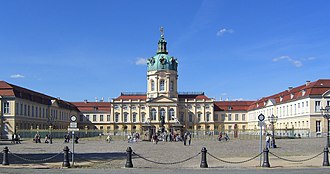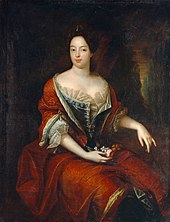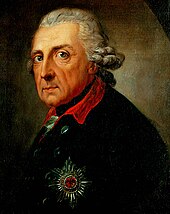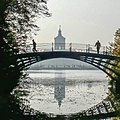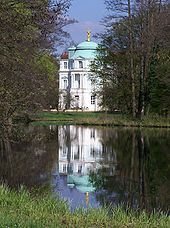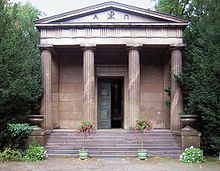Schloss Charlottenburg
The Charlottenburg Palace is a former summer residence of the Hohenzollern in Berlin district of Charlottenburg . It was built from 1695 to 1791 in several stages by Johann Arnold Nering , Eosander von Göthe , Georg Wenzeslaus von Knobelsdorff and Carl Gotthard Langhans in the style of Baroque , Rococo and Classicism . After being destroyed in World War II , it was rebuilt until 1957 and is now home to the castle museum. The monument managed by the Prussian Palaces and Gardens Foundation is a popular sight and the most important palace complex in Berlin. The palace garden with the Belvedere , the mausoleum and the New Pavilion also belong to the building ensemble .
history
After Sophie Charlotte of Hanover her husband Elector Friedrich III. In 1694 she had given back her country estate on Caputh near Berlin, it handed over the village of Lietze / Lützow about seven kilometers from Berlin as well as a piece of land as a replacement on June 30, 1695 . In the same year, Sophie Charlotte commissioned the architect Johann Arnold Nering to plan and build a summer residence. However, Nering died a few months later, and Martin Grünberg took over the construction. The core building was still very small, it comprised the central part with two risalits . In addition, because of the queen's fondness for operas and musical performances, a detached small opera house was built. This is how the palace was also called Sophie Charlotte's court of muses . The small palace was inaugurated on July 11, 1699, her husband's birthday, and has been used as a residence by Sophie Charlotte ever since. Its name was chosen after the nearby village of Lietzenburg (also: Lützenburg).
Architect Grünberg resigned from his office in 1698/1699. It was probably the builder Andreas Schlueter who initiated the further work. Two south-facing buildings were erected for the servants and the operating rooms, delimiting the courtyard.
After Friedrich's coronation as King Friedrich I in Prussia and Sophie Charlottes as Queen in Prussia in 1701, Eosander von Göthe took over the further expansion. He had the castle building widened up to the line of the courtyard buildings and this extended to the castle.
After Sophie Charlotte's death on February 1, 1705 at the age of only 36, the king named the palace and the adjoining settlement "Charlottenburg" in her honor. The king commissioned Eosander with a further expansion. From 1709 to 1712 the recessed central section was expanded into a risalit and the striking palace dome was built over it. On the west side, the building was expanded to include an orangery and a chapel. A corresponding orangery on the east side was planned, but was never implemented. The Great Orangery was used to overwinter rare plants. During the summer months, when over 500 orange , lemon and bitter orange trees adorned the baroque garden , the orangery was regularly a magnificent venue for courtly festivities.
After the death of Friedrich I in 1713, Charlottenburg Palace led a shadowy existence under his successor Friedrich Wilhelm I. However, it was against his economic sense to completely neglect the castle. The necessary maintenance measures were not denied to the building; The rooms also had to be heated in the cold season so that the “panel work and furniture did not become clogged”. He gave the freestanding opera house to the citizens for demolition as material for building a school. Friedrich Wilhelm I knew how to use the palace for official and representative purposes. It was here that the “ Charlottenburg Treaty ” was signed with George I of England in 1725 , which secured the inheritance claims to Jülich-Kleve for the Brandenburg house . There was also festive life in the castle for days when August the Strong paid a return visit to the king in the summer of 1728.
Immediately after the death of Friedrich Wilhelm in 1740, the new King Friedrich II (later called "The Great" or "Old Fritz") made Charlottenburg his residence. The king held his Masonic court box in these rooms . He felt very drawn to this place, where his beautiful and highly educated grandmother Sophie Charlotte had worked. With the Charlottenburg castle grenadiers , he had his own guard troop set up for the castle and initially set up rooms on the upper floor of the central building (old lap). The carvings of the paneling carried out by Friedrich Christian Glume - and completely lost in the Second World War - were still so clumsy that they were long mistaken for work from the 19th century. ( Friedrich Wilhelm IV. And his wife Elisabeth later lived in these rooms.) At the same time, Friedrich had given the order to have the castle extended by Knobelsdorff for his needs in the Rococo style , whereby - instead of the planned, but no longer realized under his father Eastern Orangery - the new wing was built, after Rheinsberg Castle , the second building of the Frederician Rococo . Presumably, Charlottenburg Palace did not prove to be the place of tranquility and seclusion that Friedrich II had wished for, despite its free location in the landscape. In 1744 he began converting the city palace into his permanent residence in Potsdam and building the intimate Sanssouci palace as a summer residence. He used Charlottenburg Palace, completed in 1747, for family celebrations.
The palace was given its present form under Friedrich Wilhelm II with the palace theater at the end of the western wing and the small orangery , both by Carl Gotthard Langhans . The theater building played an important role in the history of the German theater industry; it became a foster home for German literature, which was neglected under Frederick the Great . From 1795 there were free theater tickets for commoners . In the new wing , Friedrich Wilhelm II had a winter apartment set up on the south side of the first floor and a summer apartment in the style of early classicism on the ground floor of the north side facing the park . In addition, another orangery (small orangery) was built on the courtyard side opposite the large orangery. It comprised two apartments for the gardeners and a greenhouse in the middle.
The royal couple Friedrich Wilhelm III. and Luise , who lived in the castle with his children, did not make any major changes to the interior of the castle. Only after returning from Königsberg was the queen's bedroom redesigned in 1810 based on designs by Karl Friedrich Schinkel . In 1824, after his marriage to Auguste von Harrach , the king, who was widowed in the same year, had Frederick the Great's second apartment prepared for them and Schinkel built the New Pavilion for himself . A contemporary travel guide describes the room layout of the royal family in the castle as follows: “The king lives in the castle throughout the summer and has his rooms in the new one, the crown prince , the crown princess and the other princes and princesses in the old castle. The interior of the castle shows the castellan who lives in the western wing. "
Under Friedrich Wilhelm IV , rooms on the first floor of the Old Palace (central building) were refurbished as apartments for him and his wife Elisabeth in the solemn style of late classicism and neo-rococo . After the death of Friedrich Wilhelm IV in 1861, Queen Elisabeth used the palace as a widow's residence.
In the “ three emperor year ” of 1888, the terminally ill Emperor Friedrich III. the palace before he moved to the New Palace in Potsdam, where he died a few days later. From then on, Charlottenburg no longer served as a residence, but could be visited.
Use since the 20th century

From 1902 the former castle theater in the Langhansbau was converted into a furniture store. Towards the end of the First World War , some rooms in the eastern part of the Eosander building were used as a hospital . Shortly after the war, a military hospital for war invalids was housed in the new wing and in wooden barracks that were probably located in the adjacent castle park.
In 1926, the Free State of Prussia regulated the transfer of the palace to the administration of the state palaces and gardens in a contract with the House of Hohenzollern .
During the Second World War , an Allied air raid on the night of November 23, 1943 caused severe damage to the castle. The dome collapsed, the middle part of the main building, central salon and eastern part of the orangery, as well as most of the Frederician wing, burned out. Large parts of the inventory could be saved. After the division of Berlin and in view of the intended destruction of the Berlin Palace in East Berlin , the director of the West Berlin Palace Administration, Margarete Kühn , campaigned for the reconstruction of the Charlottenburg Palace from 1948 onwards . The reconstruction was completed in 1957 with the restoration of the dome. The equestrian statue of the Great Elector by Andreas Schlueter (1696) has had its place in the courtyard since 1952 . It was previously on the Long Bridge at the City Palace in Berlin-Mitte.
From 1978 to 2009 parts of the Dohna-Schlobitten collection were in the castle.
The Museum of Prehistory and Early History of the State Museums in the former theater building (Langhansbau) was established around 1960. In 2003 the museum was reopened after a thorough renovation. On April 26, 2009 the collection in the palace theater was closed and housed in the Neues Museum in Mitte , while the workshops initially remained in the palace. In the future, the Hohenzollern Museum is likely to be housed there, which was located in the destroyed Monbijou Castle in Berlin-Mitte opposite today's Bode Museum . There is currently a restaurant in the Small Orangery , and the building's glass house is used for art exhibitions and concerts in summer. The destroyed Great Orangery was also rebuilt based on the baroque model. The light-flooded ballroom offers an attractive setting for cultural events, concerts and banquets, including for the federal government, which adopted US President Barack Obama with a state banquet here in 2013 .
The KPM porcelain collection of the State of Berlin in the Belvedere , the New Pavilion and the mausoleum can be viewed separately .
From 2004 to the beginning of 2006, Charlottenburg Palace was temporarily used by the Federal President as long as its official residence, Bellevue Palace , was being renovated. Today the castle can be visited as a museum. You can see the apartment of Frederick the Great, the crown insignia of Frederick I and his wife Sophie Charlotte, the porcelain cabinet , the Golden Gallery and numerous paintings, including an important collection of 18th century French painting, including Watteau's embarkation for Kythera .
Rooms and artistic equipment
The court painters Augustin and Matthäus Terwesten and Antoine Pesne furnished several rooms of the new building with mythological - allegorical ceiling paintings.
The amber room was originally intended for Charlottenburg Palace - a complete wall paneling made of amber , which was later to be referred to as "the eighth wonder of the world ". It was designed by the architect and sculptor Andreas Schlueter. The red damask chamber is assumed to be the room . The work was mentioned in 1712, but was no longer completed for Charlottenburg. Parts of the amber paneling are to be installed in the Berlin City Palace in a cabinet adjacent to the White Hall. Friedrich Wilhelm I then gave the Amber Room to the Russian Tsar Peter the Great in 1716 as a present.
In 2007, all 20 are after eleven years of restoration work again Attica sculptures on the balustrades returned the roof after the renewal of the mold lines and the paint film was completed. As early as 1970, the 2.5-meter-high sculptures were erected as "modern" new creations based on the Baroque . In 1996 they were first placed in the garden next to the Small Orangery after a risk of falling was determined.
organ
In the chapel of the castle (Eosander Chapel) there was once an organ made by the organ builder Arp Schnitger ( Hamburg ). The instrument was built at the beginning of the 18th century and inaugurated around 1706. The organ stood on a gallery in the aisle. The slider chests -instrument had 26 registers with the following disposition :
|
|
|
|||||||||||||||||||||||||||||||||||||||||||||||||||||||
The organ remained largely unchanged until the end of the 19th century. In 1888 the disposition was changed slightly by the Dinse brothers (Berlin). In 1943 the organ was dismantled and stored in the basement of the Berlin Palace , where it was destroyed in the palace fire in 1944. After the reconstruction of the Charlottenburg Palace, the organ was reconstructed between 1969 and 1970 by the organ building company Karl Schuke (Berlin).
Others
- A smaller replica of the central building with tower was used at the 1904 World Exhibition in St. Louis as the German House with a restaurant and exhibition rooms.
- The 58-meter-high tower of Neustrelitz Castle, completed in 1909, was created as a homage to the Charlottenburg castle tower. The Grand Duchy of Mecklenburg-Strelitz and the Kingdom of Prussia were historically closely linked.
- Together with the facilities opposite, the Berggruen Museum , the Bröhan Museum and the Scharf-Gerstenberg Collection , Charlottenburg Palace forms an important museum location. Between the museums at the north end of Schloßstraße - in the line of sight to the castle - the Prince Albrecht of Prussia monument from 1901 stands.
- The palace and palace park repeatedly formed the backdrop for filming. In 1985, part of the filming of the music video of the British rock band Marillion's Kayleigh song took place here. In 2004, a scene from the Jackie Chan comedy Around the World In 80 Days was shot here, set in France .
- Postage stamp issues with images of the castle appeared in 1956 (Deutsche Bundespost Berlin, 40 Pfennig), 1982 (Deutsche Bundespost, definitive 120 Pfennig), 1987 (Deutsche Bundespost Berlin, block 750 years Berlin, 50 Pfenning) and also in 1987 as a machine stamp . In 1978 a postage stamp was issued by the Deutsche Bundespost Berlin with an image of the Belvedere in the palace gardens (40 Pfennig).
- On the day of issue January 30, 2018, 2 euro commemorative coins designed by Bodo Broschat with the castle motif on the face were put into circulation.
- On the dome of the castle there is a 4.50 m high gold-plated Fortuna figure , which serves as a wind vane . Originally completed by Andreas Heidt in 1711, the new creation was made from sheet copper in 1956 based on a design by Richard Scheibe .
Castle garden
The 55 hectare Charlottenburg Palace Garden ( popularly known as "Palace Park") was laid out by Siméon Godeau as a French Baroque garden from 1697 . It comprised a baroque ground floor on the garden side of the main building, a west and an east bosket on the Spree with three fishing houses and a small harbor for the barges that went to Berlin twice a day. There was also a play garden with water basins , lanes for boules and a pheasant garden . His office at Charlottenburg Palace ended in 1709 after the gardener spontaneously cut a large number of linden trees without asking .
During his reign between 1713 and 1740, Friedrich Wilhelm drastically cut the budget for maintaining the palace gardens. He partially covered the costs by selling herbs and rare plants and leasing the back meadow. He gave an area of the plant to the arable farmers for their own cultivation. From 1740 to 1786 Friedrich II took care of the restoration of the pleasure garden, this time in the modern Rococo style .
During his reign from 1786–1797, Friedrich Wilhelm II joined the romantic trend with his preference for English landscape gardens , which was in stark contrast to the geometric shapes and visual axes of the baroque garden. In this sense, in 1788 he appointed the gardener Johann August Eyserbeck , son of Johann Friedrich Eyserbeck (creator of the Wörlitzer Park ), to be court gardener in Charlottenburg. A large number of proposals were made (including three plans by Eyserbeck and various designs by Georg Steiner and Peter Joseph Lenné ). First, he transformed the ground floor in front of the central building (Old Castle) into a lawn with loose grass areas and groups of trees, which were repeatedly transformed over time with different plantings; he also dissolved the straight lines of the shoreline of the carp pond and the watercourses. When Eyserbeck died in 1801, Steiner took over his office and continued the landscaping. In 1819 the horticultural artist Lenné was added. He landscaped the west rosette and gave the entire complex the final artistic touch.
Friedrich Wilhelm IV. Had the bosket behind the baroque orangery restored to the way he remembered it from his childhood. However, its design did not correspond exactly to the baroque condition.
The Belvedere tea house, built by Carl Gotthard Langhans in 1788 , and the mausoleum in the Charlottenburg Palace Park , built after 1810 for Queen Luise, are located in the palace garden . The famous grave sculpture on its sarcophagus is by Christian Daniel Rauch . The New Pavilion , built by Schinkel in 1824/1825 as a Neapolitan villa, was designed by Friedrich Wilhelm III. not shared with his second wife, Princess Liegnitz .
Two other follies that - Otahitische basket House (designed in 1790 by Ferdinand August Friedrich Voss) and the Gothic fisherman's house on the Spree (1788 by Carl Gotthard Langhans) - had to be because of their lightweight construction often repaired. 1849/1850 renewed for the last time, which were basket House in 1865 and the Angel House in 1884 demolished.
After severe devastation in the Second World War, the director of the West Berlin administration of the state palaces and gardens, Margarete Kühn, spoke out in favor of a restoration of the parterre that approximated the baroque state, as there were only a few in Germany and none at all in Berlin baroque gardens were more. The surfaces laid out in 1958 and decorated with broderie in 1967/1968 do not correspond to the original condition. Because this was considered too expensive to maintain, the ornamentation was designed using various baroque pattern books and a fountain was created in the crossroads . Despite multiple criticism of this unhistorical concept, the restoration of the design from the 1950s took place in 2001 at the instigation of the Berlin Garden Monument Maintenance , because this complex can now also be assessed as historical evidence.
The palace garden has served the residents of the adjacent, densely populated old Charlottenburg building areas as a recreational area for a long time. Since 2004, plans are in the Foundation for Prussian Palaces and Gardens , to collect an entrance fee. Against these intentions, the citizens' initiative Rettet den Schloßpark! founded.
literature
- Schloss Charlottenburg. Official leader. Prussian Palaces and Gardens Foundation Berlin-Brandenburg (ed.). 9. change Edition. Potsdam 2002.
- Guido Hinterkeuser: gates of honor, glass locker and amber room. New and reread sources on the building history of Charlottenburg Palace (1694–1711). In: Foundation Prussian Palaces and Gardens Berlin-Brandenburg. Jahrbuch 3 (1999/2000), pp. 65-102 ( digitized from perspectivia.net , accessed on February 25, 2013).
- General management of the Prussian Palaces and Gardens Foundation Berlin-Brandenburg: Sophie Charlotte and her palace. Prussian Palaces and Gardens Foundation Berlin-Brandenburg, Munich / London / New York 1999, ISBN 3-7913-2225-7 .
- Klaus von Krosigk: Neo-Baroque garden tendencies in the 20th century - Attempt to take stock of garden monument conservation approaches. In: National Committee of the Federal Republic of Germany (ed.): The garden art of the baroque. (ICOMOS - booklets of the German National Committee 28). Karl M. Lipp Verlag, Munich 1998, ISBN 3-87490-666-3 , pp. 144–157, here: pp. 150 f.
- Martin Sperlich, Helmut Börsch-Supan, Tilo Eggeling: The White Hall and the Golden Gallery in Charlottenburg Palace. In: Berlin castles. Small writings 1. Administration of the State Palaces and Gardens, Berlin 1986.
- Clemens Alexander Wimmer: The gardens of the Charlottenburg Palace (= garden monument maintenance 2). Senator for Urban Development and Environmental Protection, Berlin 1985.
- Folkwin Wendland: Berlin's gardens and parks from the founding of the city to the end of the nineteenth century. (Classic Berlin). Propylaeen, Berlin 1979, ISBN 3-549-06645-7 , pp. 366-376.
- Margarete Kühn (arr.): The buildings and art monuments of Berlin: Charlottenburg Palace . 2 volumes. Gebr. Mann, Berlin 1970, ISBN 3-7861-4010-3 .
Web links
- Charlottenburg Palace - Website of the Prussian Palaces and Gardens Foundation
- Charlottenburg Palace - The official capital city portal
- Historical plans of the palace gardens - website of the district administration Charlottenburg-Wilmersdorf
- Entries in the Berlin State Monument List:
Individual evidence
- ^ Charlottenburg - Old Palace Foundation Prussian Palaces and Gardens Berlin-Brandenburg (SPSG)
- ^ Historical Commission of Berlin (ed.): Charlottenburg - the historical city . Berlin 1986, ISBN 3-87584-167-0 , p. 92.
- ↑ On Friedrich's Potsdam decision see Hans-Joachim Giersberg : Friedrich als Bauherr. Studies on 18th century architecture in Berlin and Potsdam . Siedler, Berlin 1986, ISBN 3-88680-222-1 , p. 50 f., For use by Margarete Kühn (Lit., 1970, text volume), p. 4.
- ↑ from: Wilhelm Gundlach (Ed.): History of the City of Charlottenburg . Berlin 1905, Volume I, p. 174, Textarchiv - Internet Archive
- ↑ JGA Ludwig Helling (ed.): Historical-statistical-topographical pocket book of Berlin and its immediate surroundings . HAW Logier, Berlin 1830. google.com/books
- ^ Stephan Brandt: The Charlottenburger Altstadt , Suttonverlag, Erfurt 2011. ISBN 978-3-86680-861-4 . P. 58 f.
- ↑ Obama dinner at Charlottenburg Palace. In: berlin.de. November 6, 2014, accessed June 30, 2016 .
- ↑ More information on the Arp Schnitger organ
- ↑ Susanne Kähler: Fortuna. In: Sculpture in Berlin. HTW Berlin & Association for the History of Berlin e. V., accessed on May 20, 2020 .
Coordinates: 52 ° 31 ′ 16 ″ N , 13 ° 17 ′ 45 ″ E
